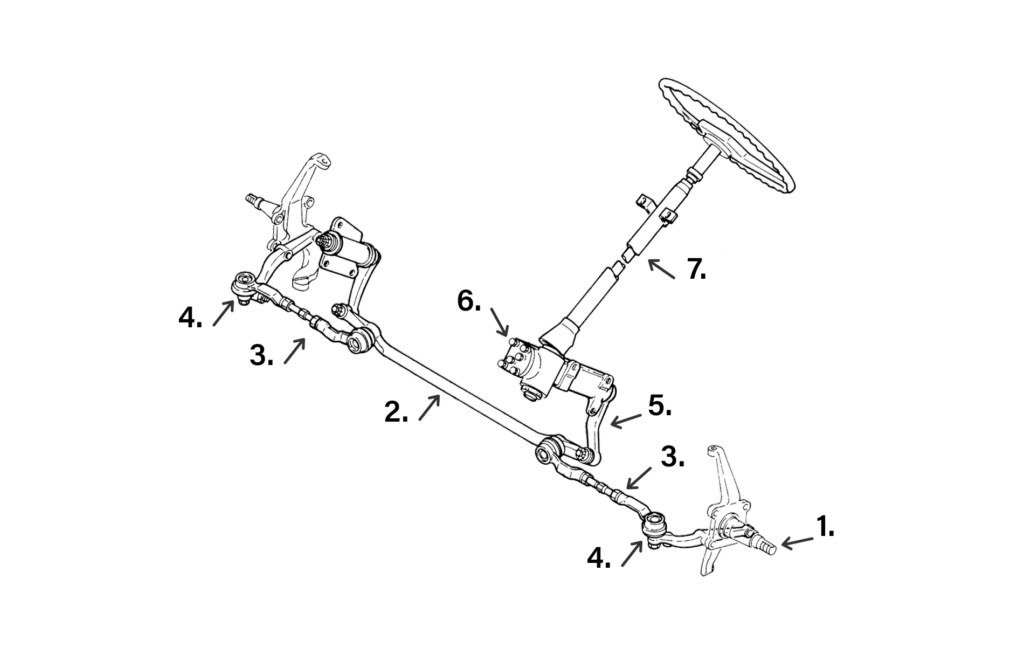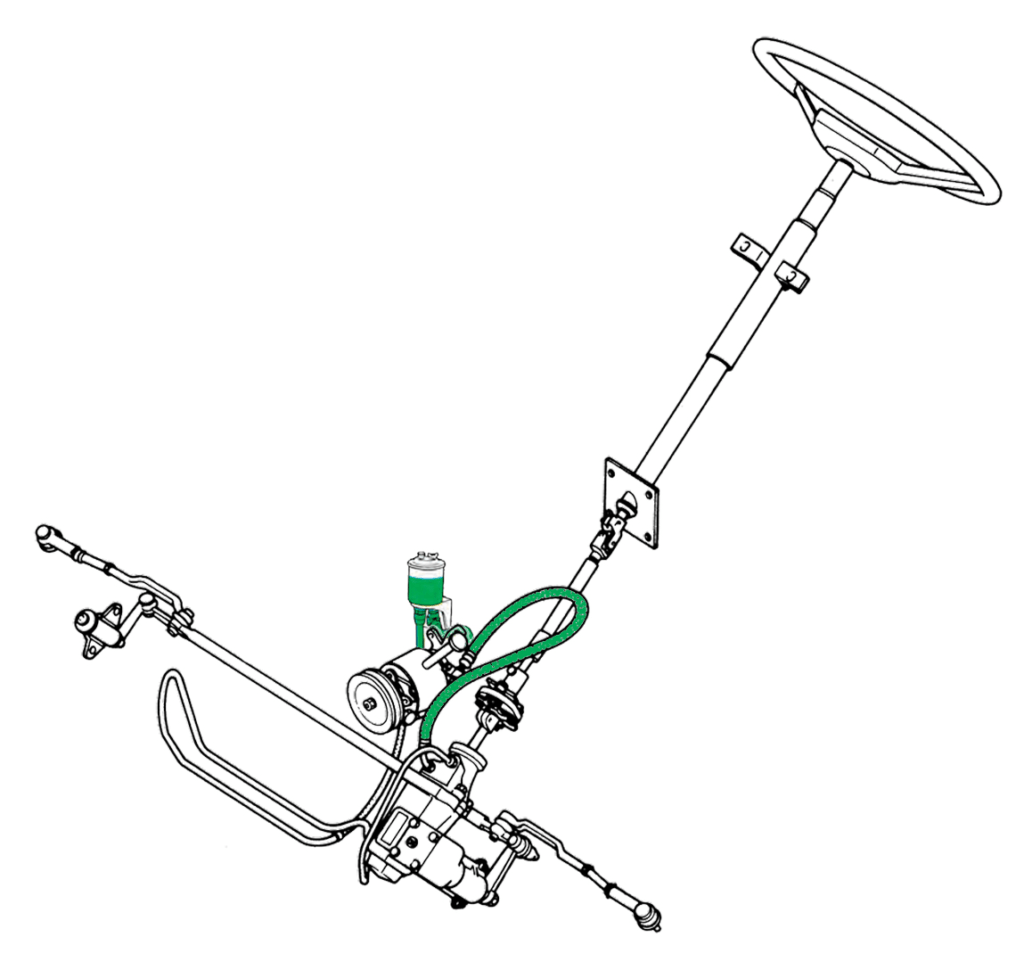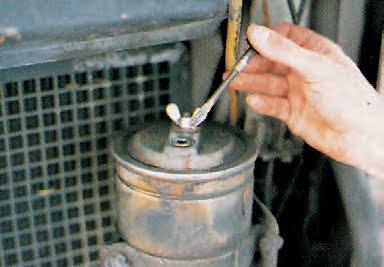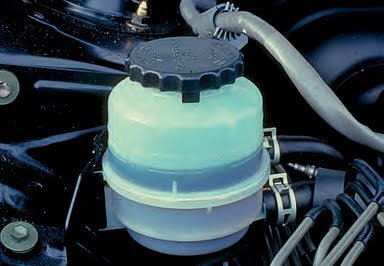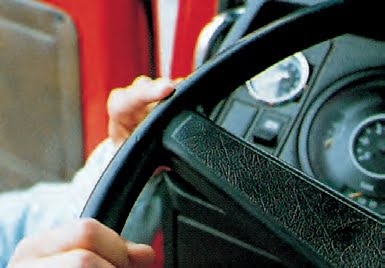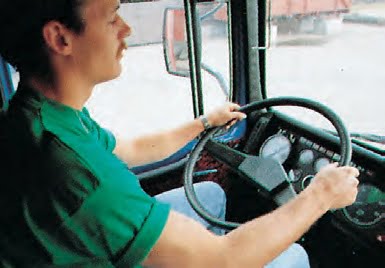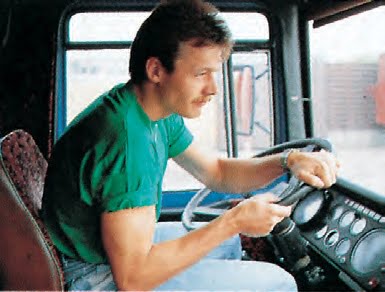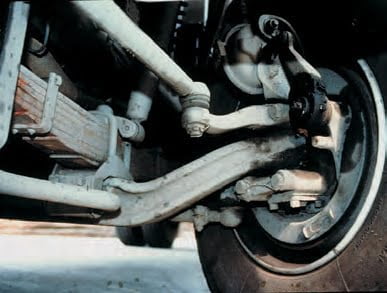large cars
Driving school
theory book
for category C - D - C/E - D/E
Large cars and lorries
Large cars - Categories C and D.
2. Steering
What you need to know about vehicle equipment and what you should be able to check yourself:
The steering system (steering gear) basically works by transmitting a turn on the steering wheel to the front wheels through the steering column, steering housing, steering arm, ball joints, tie rods, swing arms and front wheel spindles.
Power steering
To make steering easier, the steering is supplemented with power steering (hydraulic auxiliary steering).
Servo power is provided by a hydraulic pump that is pulled by the motor either directly or by belts.
Once the engine is started, the fluid circulates through the servo system as the pump sucks the fluid from the container, pushes it through the valve system and back to the container.
In principle, power steering works by turning the steering wheel to actuate the valve system and regulate the fluid pressure to the pressure roller in the wheelhouse.
In the event of a power steering failure, the car can be steered using the steering alone, but the steering will be so heavy that continued driving is dangerous and illegal.
Checking the power steering:
Check that sufficient hydraulic fluid has been added, as measured by the fluid level in the reservoir (or possibly a control light). Pipes and hoses must be tight.
New governance mechanisms:
The force required to steer a lorry is quite significant. This is evident when you consider the relative difference in front axle weight, with a normal vehicle carrying 750kg and most large trucks carrying up to 7,500kg.
HPS (hydraulic power steering) is a hydraulic steering device that provides a lot of power for its size.
SbW (Steer by Wire) replaces the mechanical steering connection between handwheel and wheel with algorithms, electronics and actuators. SbW mimics the "feel of the road", offers a wide performance range (including sporty, luxury, comfort, etc.) and improves manoeuvrability through dynamic, variable steering ratios.
Volvo has developed 'Dynamic Steering', which combines conventional hydraulic power steering with an electric motor mounted on the steering wheel. By processing input from multiple sensors, the system works out where the truck is going and what the driver intends to do. The motor is controlled 2,000 times per second to correct unintended steering movements and provide extra torque when needed.
Therefore, you should always consider the year of the vehicle you are using.
Checking the controller
The steering system is also checked by:
- To measure the steering wheel tube.
- To conduct test drives.
- Watching the tyre wear.
On a stationary vehicle, check that the steering system fulfils the following requirements: (For power steering, check with the engine running)
- The front wheels must immediately follow the movements of the steering wheel.
- Allowable wheel play, if any, according to the car manufacturer's instructions. See your car's owner's manual.
Test drive
- During slow driving, check whether the following requirements can be met:
- The steering wheel must be easy to turn from outer position to outer position without encountering abnormal resistance in the steering.
- The car must not pull to the sides when travelling straight ahead on a level road.
- There must be no noise from wheel bearings, steering wheel impacts or shaking of the front wheels and steering wheel.
- When driving slightly faster while cornering, loosen your grip on the steering wheel. The steering wheel should then automatically turn back, as the front tyres normally straighten themselves to straight ahead.
The rat droppings may be measured as follows:
- Set the front wheels in straight-ahead position. Turn the steering wheel to the left until the front wheel just moves. Then, while leaning against a fixed point, hold a finger next to a specific mark on the steering wheel.
- Then turn the steering wheel to the right until the front wheel just moves again. The distance between your finger and the licence plate shows the steering wheel tube.
Signs of a fault in the controller:
- Rat's veil.
- Noise from the controller.
- High or offensive resistance in the steering wheel.
- Uneven/skewed tyre wear.
Rat droppings can be a sign of the following faults:
- Slack in steering connections.
- The steering box is loose on the chassis.
- Play in front wheel bearings or suspension.
High resistance in the steering wheel:
High or offensive resistance in the steering wheel when cornering can be caused by:
- Lack of hydraulic oil.
- Faulty power steering.
Remember:
If the power steering fails, the truck can be steered with the steering gear alone, but the steering will be so heavy that continued driving is dangerous and illegal.
Smaller veils may be permitted:
- In trackballs.
- In a power steering wheelhouse when the engine is stopped.
Abnormal tyre wear:
Tyres that are worn unevenly (crooked) can be a sign of incorrect steering adjustment.
Other statutory provisions on the board of directors:
- The steering system must be designed so that the vehicle can be steered easily, safely and quickly
- Significant play in the steering system as a whole or in its individual parts must not occur
1. front wheel spindle - 2. Steering rod - 3. Swing arm - 4. Steering ball - 5. Steering arm - 6. Steering housing - 7. Steering column
Test your knowledge
Cat. C - D - C/E - C/E - D/E - Section 2
Select the questions you think are the right ones.
